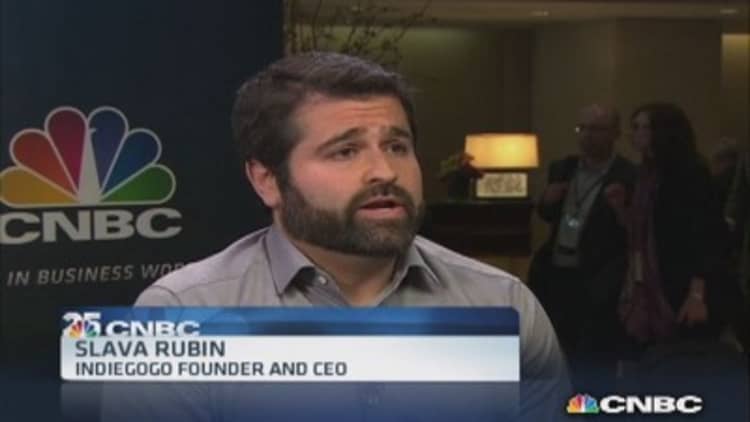
In 2009, pioneering crowdfunder Indiegogo came very close to closing up. The three co-founders were out of money. They'd been turned down by 90 VCs, and in the words of Slava Rubin, CEO, "There was not a significant amount of evidence that we were doing a good job."
Translation: Hardly anybody was coming to the site.
Five years later, the company has funded more than 200,000 campaigns and is launching a major global expansion and new website.
Earlier this year, the company landed a $40 million B round of capital from VC heavyweights, including Institutional Venture Partners and Kleiner Perkins Caufield & Byers.
It plans to expand its staff of 85 (the number of employees has been doubling every year), add more currencies to its funding platform and put money into the all-important mobile market.
And finally, it is researching an entrance into the equity crowdfunding market — giving investors equity in companies in exchange for money. Experts expect equity crowdfunding may eventually change the way small businesses are financed.
"We are absolutely committed to this goal of democratizing investing," Rubin said, pointing out that since the early 1930s, federal government regulations have kept small investors from equity stakes in private businesses. The Securities and Exchange Commission is expected to issue regulations that open the door to equity crowdfunding soon.
Though Rubin has estimated there are more than 1,000 crowdfunding platforms, the company claims it is the largest in the world. Consulting firm Deloitte said crowdfunding portals worldwide raised between $3.5 billion to $4 billion in 2013, up from $1.5 billion in 2011.
Indiegogo's new design turns the platform into a more social and personalized experience by making it easier to find campaigns in nearby geographic areas, connect to friends' campaigns and find particular campaigns of interest. Indiegogo makes money by charging fund-raisers a percentage of their campaigns in exchange for access to its user base — about 9 million unique monthly visitors. The company would not disclose revenues.
One example of Indiegogo's power: In 2012, when Karen Klein, a bus monitor in New York, was bullied by a group of seventh-graders (the video was titled, "Make the Bus Monitor Cry"), an Indiegogo member created a campaign within a minute on his mobile device and eventually raised $700,000 from people in 60 countries to give Klein a vacation. According to the company, there has been a 275 percent increase in dollars pledged to campaigns outside the U.S. In the last year and currently, about 30 percent of campaigns are launched outside of the U.S.
Indiegogo's success, in numbers and in individual stories, has taken a little bit of getting used to, the co-founders acknowledged. "A lot of outside people congratulate Slava, Eric and me," said Danae Ringelmann, referring to third co-founder Eric Schell. "It always makes me a little uncomfortable, because we would not be here if it were not for the 85 people who show up every day. Great companies have great people."
Read MoreLet the great crowdfunding revolution begin ... soon
The company was born in 2006, though it officially launched in 2008. Ringelmann had been working on an idea to create a fund to finance small projects but running into the federal regulations, which made a start-up difficult. She met Schell, who suggested she meet his friend Rubin.
"Slava flew out and ... we took him across the Golden Gate Bridge," Ringelmann said. "And we were getting out of the car just to look at the view. "He said, 'Why did you go to business school?' and we stood out there for two hours in the cold, just talking. It was the beginning of the guys being involved."
They decided early on not to take on the question of equity crowdfunding, given the federal regulations. "We decided, 'Let's not boil the ocean. Let's prove social fund-raising first,'" Ringelmann said.
They had enough money to make it through 2008 and then somehow kept pushing the site along through 2009. That's when they finally decided the idea wasn't working. The co-founders talked about quitting or going part-time.
"I was very adamant that if we go part-time, we might as well call it quits. Either you're in or you're out," Rubin said.
Then the site's growth trajectory changed. Rubin said three things happened then, and as many entrepreneurs know, success often comes from a confluence of changes. In 2009, Indiegogo threw open its platform so that anyone could raise money for anything. The co-founders spent more time on iterating the design to simplify the experience for customers. And the team began actively reaching out to clients. The turnaround came just in time.
Were they eating peanut butter? "I was very thin," said Rubin.
Read MoreCrowdfunding 2.0: A new era for start-up finance
His entrepreneurial drive, he believes, came from his parents and the early death of his father. They immigrated to the United States from Belarus in search of religious freedom. When Rubin was 15, his father died, so Rubin had to take on more responsibility for the household, which suddenly had its income cut dramatically. "We had to figure out ... what college I was going to go to — whether we should refinance the mortgage," he said. "I switched to public school for high school."
Along with an internal drive, the entrepreneurs at Indiegogo have been motivated by a focus on a clear problem they wanted to solve: how people could raise funds without having to go through gatekeepers, whether they are banks, venture capitalists or consulting firms in the nonprofit world.
It's a pay-it-forward strategy that has been gradually catching fire all over the world.
Lessons learned:
—Ringelmann: Don't wait for perfect. You learn so much by having people experiment with what you put out there.
—Rubin: Think big, start small, and iterate quickly.
—Rubin: People like to jump on a moving train. But if you're going to be an entrepreneur, you have to be the one moving the train.





